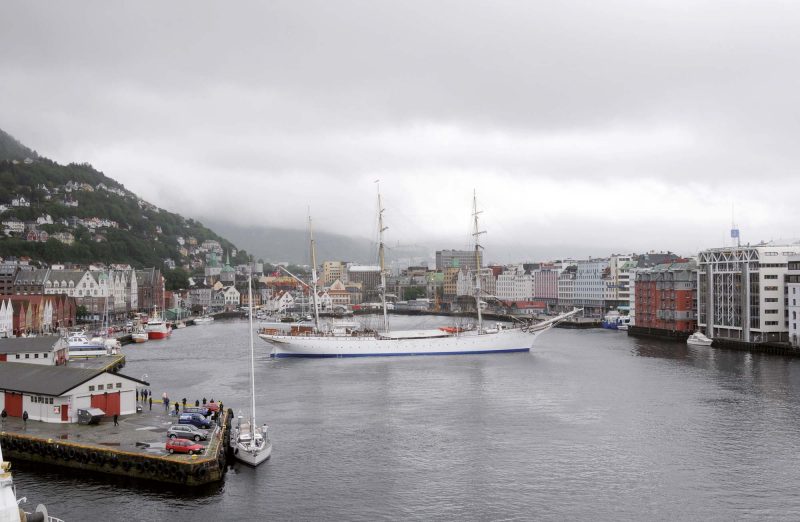
Bergen is known as the ‘Gateway to the Fjords’ and is reached by a beautiful sea passage through channels between many islands to the west of the city and port. The sea passage includes passing beneath two bridges, one to Askoy island and the other to Litlesotra. The city and port lies on the peninsula of Bergenshalvoyen at the head of Byfjorden fjord, with the city having a population of 279,000 and the metropolitan area of Bergen having a population of 425,000. Bergen is the busiest port in Norway with 314 cruise ships calling between April 2017 and April 2018, this number having doubled in the last ten years. Bergen is also a very important centre for the offshore oil industry and subsea technology. The best way to see the port is from the top of Mount Floyen, reached by a quaint funicular railway to give panoramic views of the port and surrounding area. Bergen is very proud of its Bryggen World Heritage Site on the main Vagen harbour, and of its long history of seafaring, with the Bergen International Seafarer Centre opened on 24th May 2016 as the only one of its kind in all of Norway.
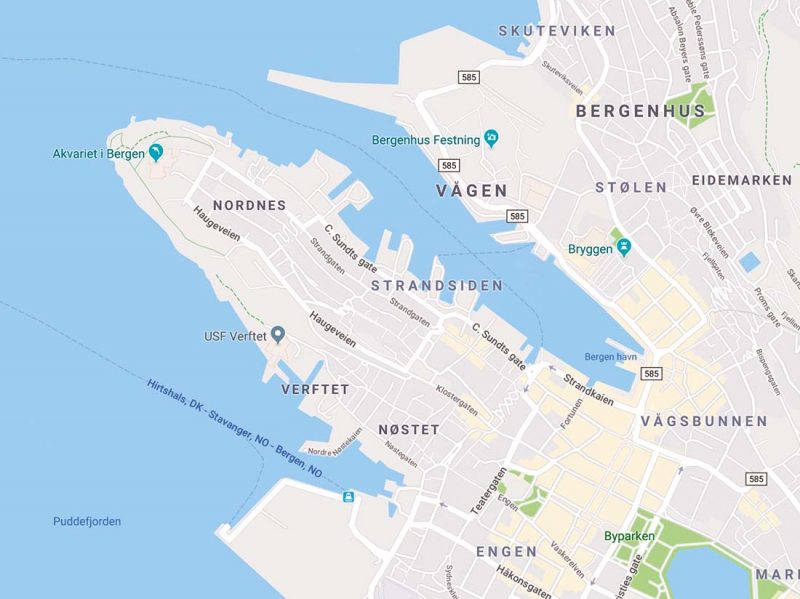
History Of Bergen

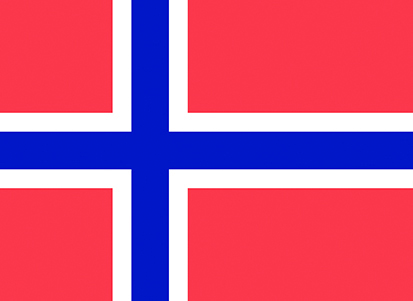 King Olav Kyrre granted town status to Bergen in 1070 as it was the largest town in Norway and capital of Norgesveldet, a region that included Iceland, Greenland and parts of Scotland. Bergen replaced Trondheim as the capital of Norway in 1217, and later Christiania, renamed Oslo in 1912, became the capital of Norway in 1299, but Bergen continued to grow in leaps and bounds as a trading centre. Bergen has always been and remained thus for centuries as the King’s town with his personal bodyguard and followers ensconced in the heavily fortified Bergenhus (Bergen Castle).
King Olav Kyrre granted town status to Bergen in 1070 as it was the largest town in Norway and capital of Norgesveldet, a region that included Iceland, Greenland and parts of Scotland. Bergen replaced Trondheim as the capital of Norway in 1217, and later Christiania, renamed Oslo in 1912, became the capital of Norway in 1299, but Bergen continued to grow in leaps and bounds as a trading centre. Bergen has always been and remained thus for centuries as the King’s town with his personal bodyguard and followers ensconced in the heavily fortified Bergenhus (Bergen Castle).
Tyskebryggen (The German Quay), now called the Bryggen row of two storey timber gabled houses, with formerly sleeping quarters above businesses on the north side of the main Vagen harbour is a current reminder of the almost total influence that German trade had over Bergen between the end of the 13th century until 1754. The Hanseatic League was in control of the Baltic trade and its ports, which explains why Bergen exports of salted codfish and furs in return for foodstuffs not available in Bergen were under the control of the Hanseatic ports of Lubeck, Bremen and Rostock. The Bryggen housed powerful German merchants in a defensible area of double rows of long wooden sheds, with warehouses and business premises on the narrow ground floor and living quarters above. As in other ports controlled by the Hanseatic League, this area was known as a Kontor, which in fact was walled off for the decade of 1520s before the town insisted that the wall was pulled down. The total trading influence of German merchants was only broken after the trade monopoly of Bergen with Northern Norway and with Sweden gained strength in the early 18th century and most of the German merchants returned home in 1754. An ultimatum from the King of Norway finally managed to make the German Kontor merchants either go home in 1754 or become citizens of Norway.
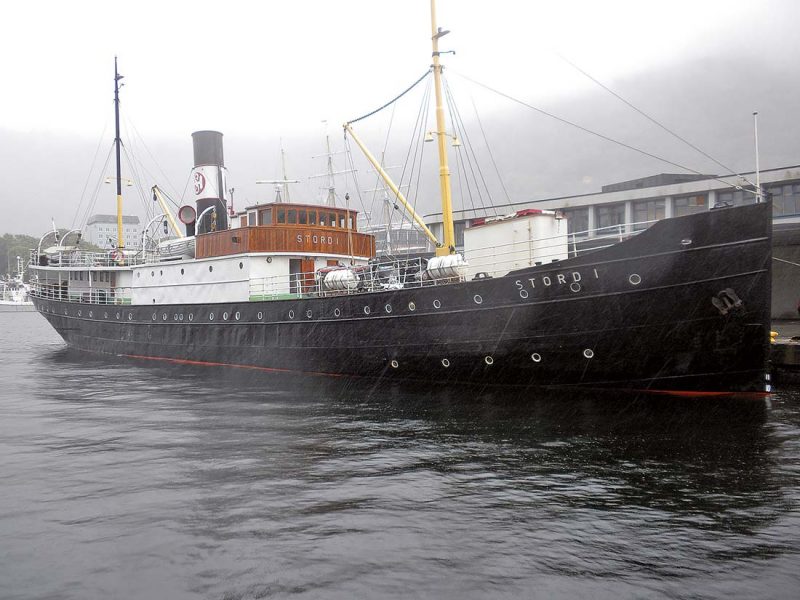
The Hanseatic League influence, however, remained strong for some time afterwards as some German merchants and craftsmen settled in the town to keep their strong mercantile and cultural influence alive. Their medieval timber gabled houses were often burned down by fires and rebuilt, but the last fire in 1955 left only ten gables standing. Excavations after this 1955 fire revealed archaeological treasures of the medieval era and led to the establishment of the Bryggen Museum. The green spaces of the Bergenhus Festning, between the Skolten North, Skolten South and Bontelabo ferry and cruise terminals and the Bryggen, contain a Gothic ceremonial hall built for King Haakon Haakonson for the coronation and wedding in 1261 of his son Magnus Lagaboter. Rosenkrantz Tower is adjacent to the ceremonial hall and is part of the old fortifications of the Bergenhus built in 1260 and modified exactly three centuries later.
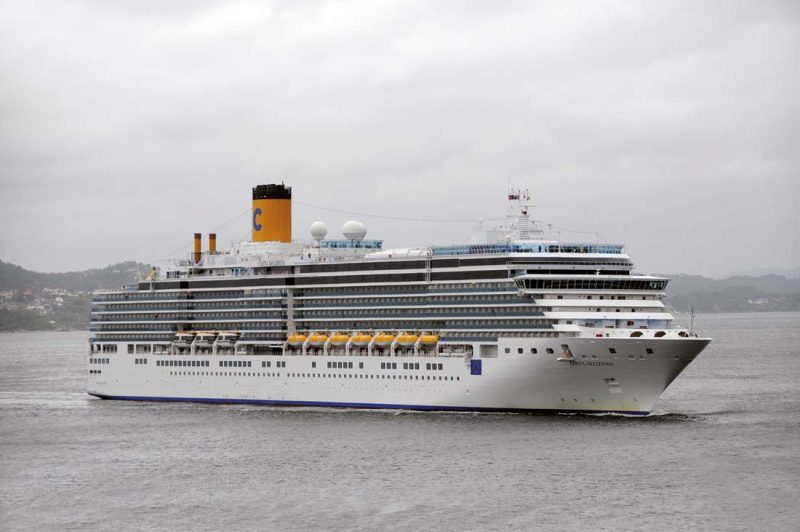
A full scale naval battle took place in the main Vagen harbour in 1655 between the British and Dutch navies for control of the exclusive rights to trade between Central and Northern Norway and the North Sea and Baltic Sea areas. The garrison at Bergen supported the Dutch, and Bergen continued to look towards mainland Europe instead of Britain for trade, becoming the biggest city in Norway until Christiania outgrew it in the 1830s.
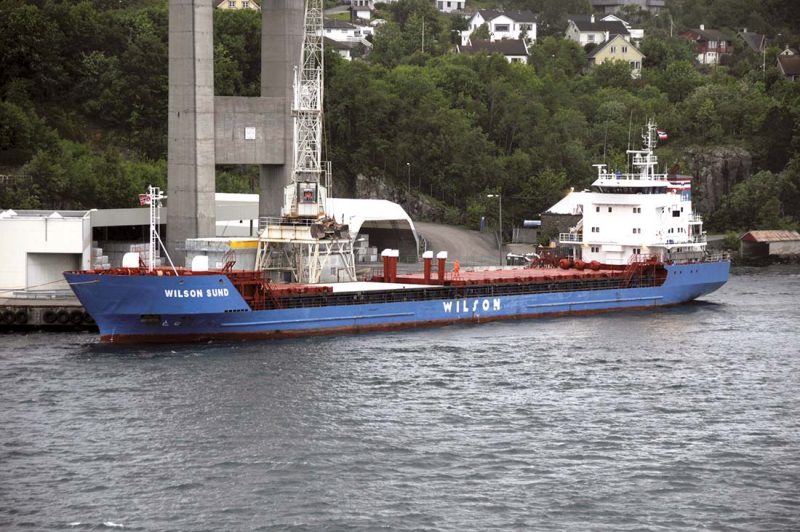
The Port of Bergen was occupied by German warships and supply ships in the early hours of 9th April 1940. The Dutch cargo ship Verboode carrying more than 120 tonnes of high explosives blew up in the main Vagen harbour in 1944, killing over 150 people and damaging many historic buildings. R.A.F. bombers also continually bombed shipping in the Vagen and Puddefjorden (south of the Vagen) anchorages and quays with the unfortunate loss of around one hundred Bergen citizens. Several municipalities formed the city of Bergen in post-war years, including on the island of Askoy to the west and at Sandviken to the north of the city. There are important oil terminals in the vicinity of the wider Bergen and Hordaland area at Skardholmen (Sears Oil), Mongstad and Sture (Statoil), and Skalevik (Exxon and Esso Norge). The offshore oil industry in the Norwegian sector of the North Sea has become of huge importance to the Port of Bergen since 1965, with the quays in the Puddefjorden (a vast sea and harbour area of 30 square kilometres) and the narrow Damsgaardsundet harbour leading off Puddefjorden thronged with dozens of oil rig supply vessels.
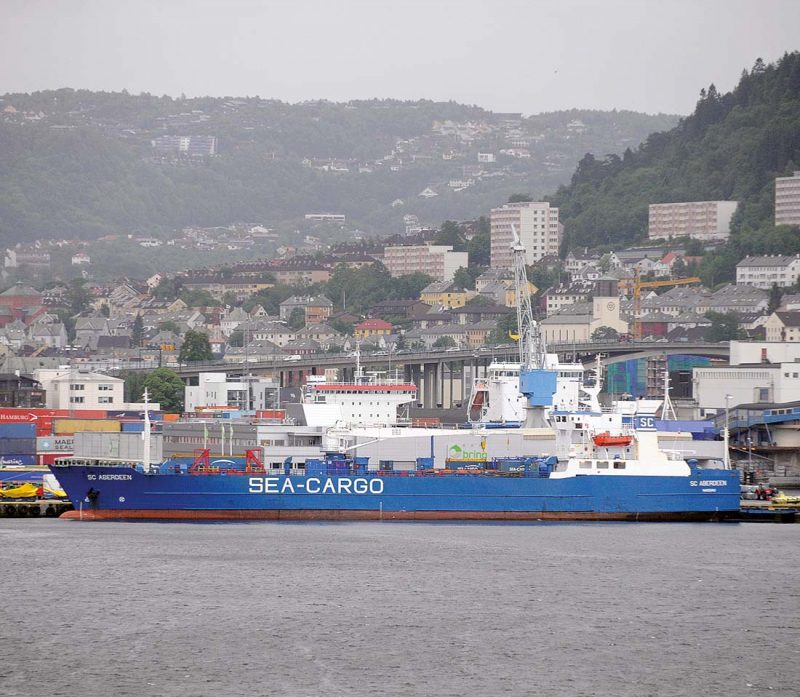
Bergen Aquarium on the tip of the Nordnes peninsula between the Vagen and Puddefjorden harbours, became important internationally in post-war years as it contains the largest collection of seawater and freshwater fish and invertebrates in Europe. The aquarium has nine very large tanks and forty smaller tanks holding 660,000 gallons of seawater, which are changed daily by pumping seawater from the sea and harbour through eight thousand metres of plastic pipes. The aquarium is a major tourist attraction in Bergen within easy walking distance of all cruise terminals.
Port Of Bergen Facilities
There are 11,000 metres of quays in the port that are mostly owned by the municipal authorities, and warehouses of 50,000 square metres including four cold store reefer plants. The Port Authority (Bergen og Omland Havensesen) has port and municipal authority representatives from a dozen municipalities on its Board of Directors including Askoy, Austrheim, Bergen, Fedje, Fjell, Lindas, Meland, Os, Radoy, Sund, Oygarden and Hordaland County. It administers and manages the harbours and sea areas around Bergen under the Norwegian Harbour Act, and plans, maintains and constructs public port facilities. The total trade of imports and exports of the Port of Bergen in 2015 was 43.888 million tonnes, of which 98.7% passed through private wharves including the oil trades from the big oil terminals in the Bergen and Hordaland outer area, as well as dry bulk, general cargo, container, fish, and offshore drilling and rig supply cargoes.
Cruise ships are also of huge importance to the tourist industry of the Bergen and Flam areas, with 314 cruise liners calling at the port between April 2017 and April 2018 with over half a million tourists. On busy days, eight cruise ships are to be seen at most of the big quays in the port, which are as follows:-
- Skolten North Ferry and Cruise Terminal of length 333 metres
- Skolten South Ferry and Cruise Terminal of length 330 metres
- Bontelabo Ferry and Cruise Terminal of length 133 metres
- Tollboden Quay (opposite Skolten South in Vagen harbour) of length 109 metres
- Festningskaien Quay of length 300 metres in Vagen harbour
- Jekteviken Quay in Puddefjorden of length 500 metres and two ro-ro berths
- Dokkenkaien Quay in Puddefjorden of length 240 metres
- Hurtigruten and Ro-Ro Ferry Terminal for Stavanger and Hirtshals in Puddefjorden of length 300 metres, not normally available for cruise ships.
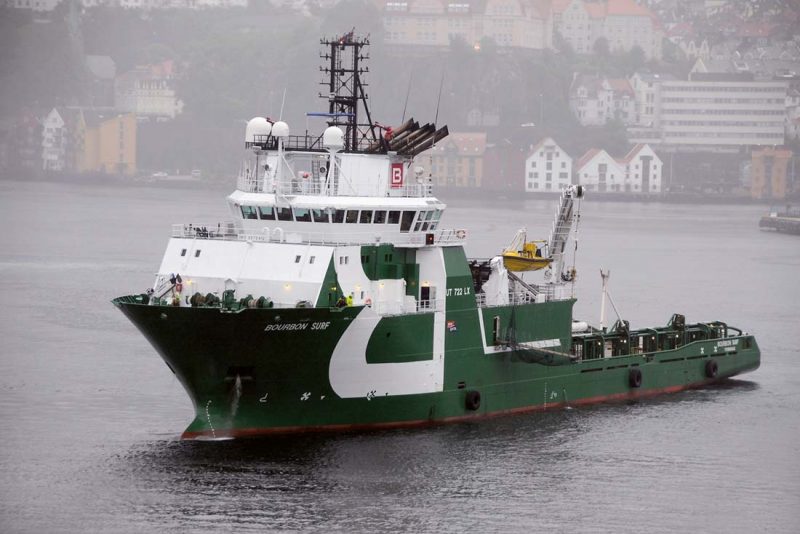
Cruise ship passengers arriving at the Jekteviken and Dokkenkaien quays have since 2016 been shuttled by bus to the rear of the car park at the Hurtigruten terminal. The way into the centre of Bergen is now marked by white painted dots and arrows, with a walking distance of 600 metres. Wheelchair passengers will continue to be taken by minibus to the city centre, and picked up again at the same place for the return to the cruise ship. The new shuttle route will reduce vehicle congestion in the tourist centres of the city. The largest port investment has been made at the Dokkenkaien quays with 34.4 million NOK invested in 2015 and a total so far of 88.5 million NOK.

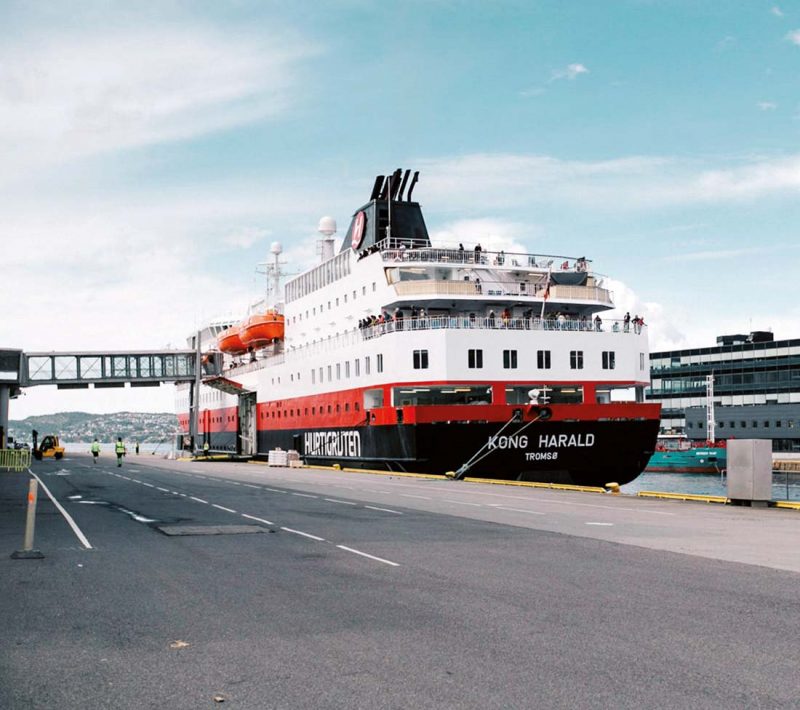
There are also two small ferry terminals in Vagen harbour for local residents of the nearby islands to the west and north of the city. There are also cargo berths and grain silos at Hegreneset, Nostekai, Sydnes, and in the Damsgaardsundet narrow harbour at Frielenskaien, Mohlenpriskaien and Damsgardskaien. A large Gottwald heavy lift and container handling crane of lifting capacity of between 100 and 125 tonnes depending on outreach is provided. The crane has a weight of 360 tonnes, with the operator tower cab at 22.0 metres off the ground, a working radius of between 11.0 and 51.0 metres, and a boom pivot point of 16.7 metres. A new quay and port will be built on reclaimed land between the east end of Dokkenkaien and the Frielenskaien quays normally used by offshore oil rig supply vessels.
Cruise Ship Calls From April 2017 To April 2018
- Aida Cruises 41
- Costa Cruises 26
- Cruise & Maritime Voyages 22
- Holland America Line 22
- P. & O. Cruises 21
- TUI & Marella Cruises 19
- Viking Ocean Cruises 18
- Fred. Olsen Cruises 8
- Phoenix Reisen 16
- MSC Cruises 14
- Norwegian Cruise Line (NCL) 11
- Saga Cruises 7
- Cunard Line 6
- Princess Cruises 5
- National Geographic Cruises 5
- Pullmantur Cruises 5
- Hurtigruten Cruises 4
- Regent and Oceania Cruises 4
- Rivages de Monde 4
- Silversea Cruises 4
- Windstar Cruises 4
- Premier Cruises 3
- Seabourn Cruises 3
- Celebrity Cruises 3
- Royal Caribbean International 3
- Gap Adventures 3
- Apex Tours 3
- Ponant Cruises 3
- Plantours & Partner 3
- Hapag Lloyd Cruises 3
- Noble Caledonia 2
- Hebridean Cruises 2
- FTI Touristik Cruises 2
- Icelandic Cruises 1
- Sea Cloud Cruises 1
- Azamara Cruises 1
- Crystal Cruises 1
- Disney Cruise Line 1
- TOTAL 314
Hurtigruten Services From Bergen
Capt. Richard With of the Vesteraalens D/S shipping company began the Norwegian Coastal Express service by winning a Government contract amid much controversy in May 1893. The controversy was due to indecision in deciding whether the State or private companies should be allowed to run the service, the Government having appointed an adviser in 1889. The Government contract was for weekly sailings and nine ports of call between Trondheim and Hammerfest in summer, and in winter the service terminated at Tromso. The northern parts of the coast had very rough weather in winter, with few lighthouses or navigation points in the almost perpetual darkness of winter, with navigation often done by compass, chart and stopwatch.
The steamer Vesteraalen, built in 1891 for the shipping company of the same name, was the only steamer willing to make such a dangerous voyage in such poorly charted waters during the long, dark winters. She took 35.5 hours on her first voyage on Sunday 2nd July 1893 from Trondheim with nine intermediate calls including Svolver and she reached Hammerfest after 67 hours under the command of Capt. Richard With. The voyage was a substantial breakthrough for communities along its path as mail from Central Norway to Hammerfest could now be delivered in seven days instead of three weeks in summer and five months in winter previously.
Several other shipping companies were encouraged by her success to participate in the Hurtigruten sailings, which were extended from Bergen in the south to Kirkenes in the north, with eleven passenger ships needed to operate the eleven day schedule starting from Bergen each day.
Vesteraalens D/S had been founded on 10th November 1881 by Capt. Richard With at Stokmarknes, and just over a century later the company merged in 1987 with Ofotens D/S, established in 1912, to become Ofotens and Vesteraalens D/S (OVDS). The OVDS main office was in Narvik while the ferry section was located at Stokmarknes. The combined company had 1,500 employees at the time of the merger and operated fourteen coastal passenger ships and eighteen car ferries of up to 3,000 grt. Other companies that participated in the Hurtigruten services included Bergen Line, Det Nordenfjeldske D/S, Det Stavangerske D/S and Troms Fylkes D/S.
Det Nordenfjeldske D/S built the first post World War II Hurtigruten vessel in 1949 as Erling Jarl of 2,125 grt, followed by Hakon Jarl 2,173/52, Ragnvald Jarl 2,196/56 and Harald Jarl 2,568/60. Erling Jarl suffered a fire onboard at Bodo harbour on 8th January 1959, with fourteen people killed by thick suffocating black smoke, with a memorial later erected in Bodo high street to commemorate the loss of life. Det Stavangerske D/S had Hurtigruten passenger ships named Sanct Svithun, including one completed in 1927 and another in 1950. The latter ship ran onto a reef in the Folda area in Nord-Trondelag on 21st October 1962 due to a major navigational error when sailing from Trondheim which resulted in the death of 41 of the 89 persons on board. The lost ferry was replaced on the Hurtigruten by Kong Olav of 2,637 grt from the Bergens Mek Verksted (BMV) yard in April 1964, and which served for 33 years on the express service until withdrawn in 1997. She had accommodation for 510 passengers and cost 16.5 million NOK to build.
Bergen Line was founded in 1851 by Michael Krohn for services from Bergen, Stavanger and Kristiansand to Hamburg and Altona. The company ships had a nomenclature of stars and constellations, and contributed many ships to the Hurtigruten service from June 1894 at Government request. Bergen Line continued on the service until 1979 using the following ships:-
- Sirius 962/1885 for a year 1894-1895
- Jupiter 652/1856 from 1896 and as a relief ship until 1912
- Orion 681/1874 on service during 1898-1903
- Capella 877/1885 on service during 1898-1910
- Astraea 765/1900 on service during 1900-1910
- Lyra 784/1905 on service during 1905-1913
- Midnatsol 978/1910 gave forty years service until withdrawn in 1950
- Hera 1,097/1889 on service during 1910-1931
- Polarlys 1,070/1912 gave forty years service until withdrawn in 1952
- Mira 998/1891 on service during 1927-1939
- Nordstjernen 1,919/1937 on service during 1937 until she stranded and sank at Raftsund on 22nd September 1954
- Ariadne 2,029/1930 on service 1939-1940 until bombed and sunk outside Tromso on 9th June 1940
- Midnatsol 2,098/1949 on service 1949-1982 but sold to TFDS in 1979
- Nordlys (2) 162/1951 on service 1951-1983 but sold to TFDS in 1979
- Polarlys (2) 163/1952 on service 1952-1994 but sold to TFDS in 1979
- Nordstjernen (2) 2,194/1956 on service 1956-94 but sold to TFDS in 1979, returned to Hurtigruten during 1995 and for a winter relief service during 2005/06 on charter to Ofotens and Vesteraalen D/S (OVDS)
The last Bergen Line quartet was sold to Troms Fylkes D/S (TFDS) on 24th January 1979 for NOK 32 million ($6.3 million), the contract being signed in secret. Bergen Line bowed out of the Hurtigruten service on 30th August 1979 when Nordlys and Polarlys were withdrawn, with Nordstjernen (2) and Midnatsol following five days later. TFDS was established in 1866 in Tromso with the first small steamer named Tromso put into operation during the following year. TFDS had sixteen small passenger vessels of up to 350 grt in their fleet in 1973, with their first small fast catamaran, Fjordkongen of 25 knots service speed, introduced in 1975.
TFDS built the first new larger generation of Hurtigruten vessels in 1982 as Midnatsol of 6,167 grt with accommodation for 550 passengers, and with a sister following in 1983 as Vesteralen for Vesteraalens D/S. The role of the Hurtigruten was beginning to change in 1982, in part because of competition from air and road travel, as well as operating subsidies being gradually phased out by the Norwegian Government, and thus need for the remaining operators to supplement their income by tourism.
The last two operators, Troms Fylkes D/S (TFDS) and Ofotens and Vesteraalens D/S (OVDS) merged together on 1st March 2006 to form a new company named Hurtigruten Group ASA. The last Board meeting of TFDS had taken place on 19th December 2005 when the resolution to conclude the merger was voted for unanimously, the exchange percentage in the new company being 58% for OVDS and 42% for TFDS. During the period from 1993 to 1996, TFDS had introduced three larger passenger sisters into the Hurtigruten service in Kong Harald 11,204/1993, Nordlys 11,204/1994 and Polarlys 11,341/1996 with accommodation for 691 passengers. The merged Hurtigruten Group ASA fleet in 2007 comprised fourteen passenger vessels with most operating on the Hurtigruten express service, but with others including the new Fram 12,700/07 operating as expedition ships to Greenland, Iceland, the Arctic and Antarctic.
The current Hurtigruten Group ASA fleet comprises passenger vessels engaged on the Hurtigruten express service in Finnmarken, Lofoten, Midnatsol, Nordnorge, Nordkapp, Nordlys, Polarlys, Trollfjord and Vesteralen, together with four expedition ships in Fram, Midnatsol, and Nordstjernen with two more recently delivered or under construction as Roald Amundsen (2019) and Fridtjof Nansen (2019). Two of the expedition ships double up as Hurtigruten vessels from time to time in order to make up the eleven vessels needed for the express service. The service has now been running almost continuously for a magnificent 125 years, except for a period during World War II when fishing boats were used, and is one of the truly great cruise ferry voyages that one can take anywhere in the world.
Bergens Mek Verksted Shipyard
This important shipyard was established on the south shore of Puddefjorden at Solheimsviken in 1855 at the instigation of Michael Krohn, founder of Bergen Line with the yard owned by Bergen Line. The shipyard built iron steamships in excellent facilities of an iron foundry, machine shop, coppersmith shop, plate bending facilities, dry dock, office building and a residence for the yard manager. The yard also had a primary purpose to repair iron and later steel steamers for Bergen Line and other local Bergen shipowners, as no such facility existed in the area. A fitting out quay was completed in 1866 and by a decade later shipbuilding was in full swing with 400 people in employment. The yard had to be renovated just before the turn of the century as it was lagging behind other shipbuilders in electrically powered machinery, workshops and lighting.
A fall in the order books in the 1920s resulted in a reorganisation of shipbuilding capacity in the Bergen area, with the Laxevag yard to the west of Bergen taken over on 1st January 1924. This yard had built only sailing ships since 1805, and following the merger, the Solheimsviken yard concentrated on building new and larger ships, while Laxevag concentrated on repair of vessels and the construction of much smaller vessels. After World War II, the Bergens Mek Verksted (BMV) facilities were extensively modernised, with three building berths capable of building ships up to 24,000dwt and with an annual output of 80,000dwt of ships. Diesel engines were built at the yard for installation in Bergen built ships, and there were three floating docks at the two facilities with dimensions of lengths 574.3 feet, 356.6 feet and 279.6 feet, as well as a dry dock completed in 1872 of length 260 feet but extended in 1898 to 364 feet in length, 55 feet wide, and 21.6 feet deep.
The yard gained an excellent reputation for building engines aft tankers, bulk carriers and general cargo ships of up to 40,000dwt in the 1960s and early 1970s, with the BMV yards having become members of the Aker Shipbuilding Group of Oslo. Prefabricated sections of up to eighty tonnes in weight could be moved around the yard by fourteen cranes. A very large floating dock of 32,000 tonnes lifting capacity was brought to the yard in 1991, and had been built at Wallsend on the Tyne in 1912 as Admiralty Floating Dock 4 (AFD4) and was used at Devonport and Chatham naval bases, and later at Rotterdam and Gothenburg. The Hurtigruten ferry Kong Olav of 1964, the passenger ro-ros Cornouailles of 1977, Rostock of 1977, and El Arish of 1980, as well as the parcel tankers Jo Lonn, Jo Birk and Jo Oak of 35,000 dwt for Jo Tankers A/S and completed in 1982/83 were some of the products of the yard. The yard closed in 1985 after fitting out a hull launched elsewhere, with the BMV company liquidated four years later.
Postscript
The Fisketorget (Fish Quay) has great memories for me during my two visits to Bergen on the passenger ferry Leda of Bergen Line. The picturesque Fish Market is one of the most visited outdoor markets in Norway, and sells fresh fish, seafood, fruit and vegetables, all beautifully laid out on freezer tables packed with ice to keep them fresh. One can buy a trout or fish of one’s choice and take it to a nearby restaurant to have it grilled to perfection. The fish market has been a meeting place for fish merchants and fishermen for centuries, and there is also an indoor contemporary building with excellent restaurants and cafes at the east end of Vagen harbour.
The sister tugs that helped to berth Leda at Bergen, Titan and Vulcanus, still exist today with Vulcanus beautifully preserved and berthed at the east end of the Vagen harbour. They were of 142 grt and built at Molde in 1959 by Bolsones Verft A/S and fitted with eight cylinder Atlas diesels to berth all Bergen Line ships that docked at Bergen. Titan is currently named Skilso and laid up, and both of these handsome tugs from a bygone era are now almost sixty years old.

The highlight of the Bergen cultural calendar is the Bergen Festspill, an international arts festival that takes a full two weeks in late May and early June.
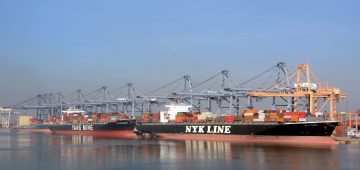



Comments
Sorry, comments are closed for this item